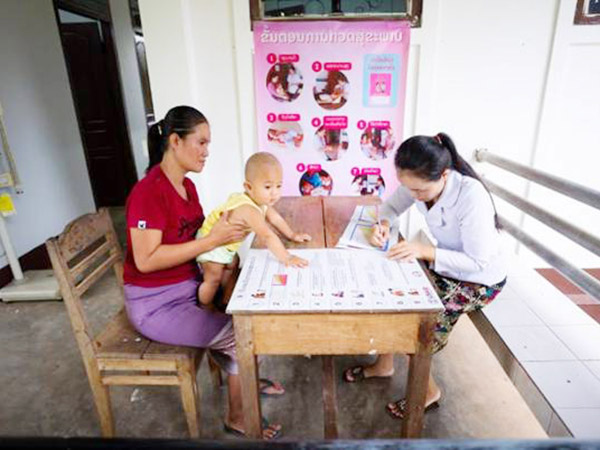

Laos has achieved good results in its efforts focused on nutrition, including reducing malnutrition among women, mothers and young children in line with the Sustainable Development Goal (SDGs) for eliminating hunger.

A nurse provides information about the benefits of nutrition to a woman.
However, there are still challenges and lessons that can be learned to improve coverage in the next round. Malnutrition remains a challenge for the development of Laos, which has some of the highest rates of malnutrition in Southeast Asia, health officials said.
Last week, the Deputy Prime Minister, Prof. Dr Kikeo Khaykhamphithoune, hailed Laos’ success in nutrition-related measures that focused on reducing malnutrition among women, mothers and children. However, malnutrition remains a challenge to the development of Laos.
Dr Kikeo made these remarks while addressing the Ninth National Nutrition Forum. He said, “Therefore, at this meeting, we will review the situation together and discuss ways to enhance closer cooperation between various sectors, such as local authorities, organisations in the private sector and society, development partners and other donors, in order for the work to gradually develop.”
He said this is a key annual event focused on nutrition in Laos. The event acknowledges that good nutrition and healthy diets are important for the people’s well-being, which is an important milestone for the socio-economic development of the country, he said.
While SDG 2 aims to create a world free of hunger by 2030, there are many difficult aspects that are obstacles to achieving the set goals, such as a low birth weight rate and heights that are not up to the standard.
The latest Lao Social Indicator Survey states that nearly two million Lao citizens, mainly women and children, suffer from some form of under-nutrition. Stunting remains high at 44 percent and affects around 385,000 children under the age of five, according to authorities.
More than one-third of children under five (35.6 percent) suffer from chronic malnutrition, while 20 percent of children are already stunted by the age of six months.
Minister of Health, Dr Bounfeng Phoummalaysith, said: “Children in target communities, especially the most disadvantaged, fully enjoy their rights to survival, development and protection.”
He said the strengthening of district health systems will ensure the implementation of the essential service package, along with continuing the care approach and supporting the implementation of nutrition-specific interventions, including for infants.
The government’s National Nutrition Committee and its Secretariat are currently rolling out the National Nutrition Strategy for 2016-25. This strategy and its plan of action provide the roadmap for what needs to be done by whom and by when. It also outlines the process by which more improvements can be achieved and sustained, he said.
The new National Nutrition Strategy and action plan aims to mainstream nutrition into the aims for overall national development and it will work across three sectors – agriculture, education and health – as well as water and sanitation.
Targets include bringing down the infant mortality rate from 68 deaths per 1,000 births in 2012 to 20 per 1,000 births by 2025, and reducing the maternal mortality rate from 220 deaths per 100,000 births in 2012 to 100 deaths per 100,000 births by 2025.